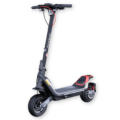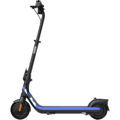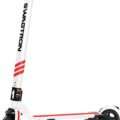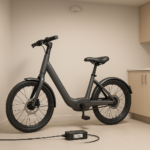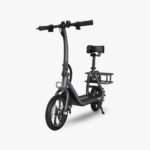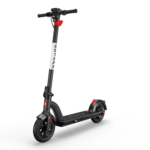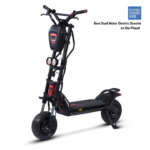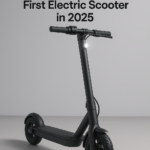- Home
- Scooters
- Electric Scooters
- Segway Ninebot GT1
Segway Ninebot GT1
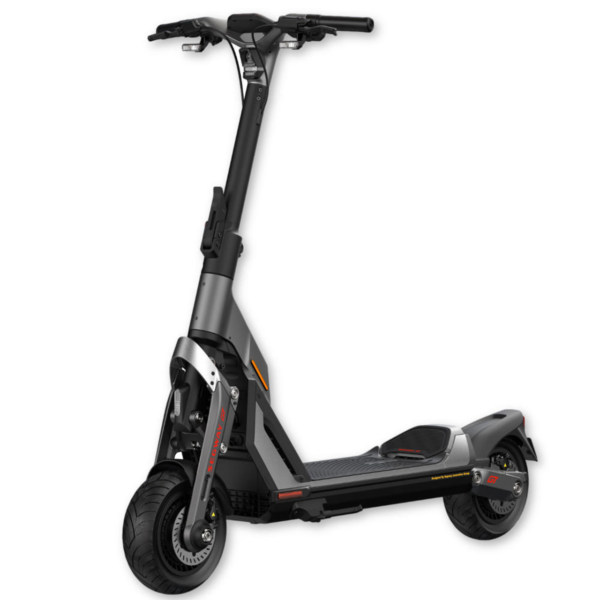

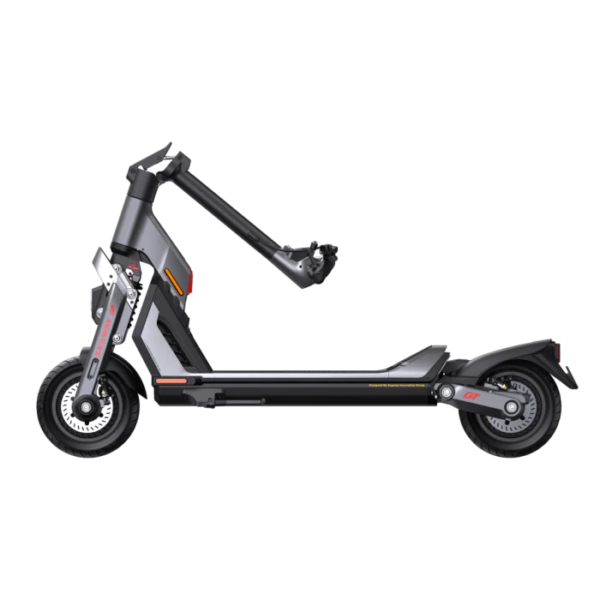

- Battery Range: 70 km
- Top Speed: 60 km/h
- Motor Power: 500 W nominal
- Weight Capacity: 150 kg
- Charging Time: 12 h (single) / 6 h (dual)
- Scooter Weight & Portability: 47.6 kg
PROS
- 1008 Wh battery with long-range capability
- Dual-arm suspension and 11" self-sealing tyres
- Robust front disc + rear electronic braking; indicators & DRL
CONS
- Heavy at 47.6 kg
- EU top speed limited to 25 km/h on GT1E


Overview
Segway Ninebot GT1 Specifications — What This Model Is
The Segway Ninebot GT1 is a performance-oriented, single-motor electric scooter built for long urban rides and stable handling at speed. It belongs to the SuperScooter family and sits below the dual-motor GT2 in outright output. Nevertheless, it emphasizes range, chassis control, and high-confidence braking. Because it ships in multiple regional versions, naming varies: GT1P models in some markets allow higher top speeds, while GT1E units in the European Union follow the 25 km/h cap. Regardless of region, the platform keeps the same core design: a robust frame, front and rear dual-arm suspension with adjustable hydraulic damping, and a 1008 Wh battery designed for steady daily distance.
Importantly, this page focuses on specifications rather than opinions. Therefore, the copy highlights measurable attributes and configurable settings that affect real-world use. Where specs differ by market, the text notes the variation so you can match the figures to your region before purchase. As a result, you can scan the sections below and quickly decide whether the Segway Ninebot GT1 specifications align with your route length, surfaces, and storage constraints.
Segway Ninebot GT1 Specifications at a Glance
- Battery: 1008 Wh (20 Ah, nominal 52 V class), onboard charging supported
- Range: up to 70 km (theoretical, standardized test); typical mixed riding ~50 km
- Motor: high-efficiency rear hub; regionally advertised peak up to 3000 W
- Top Speed: up to 60 km/h on GT1P (region dependent); 25 km/h on EU GT1E
- Climbing: rated up to 23% on suitable surfaces
- Suspension: front & rear dual-arm with adjustable hydraulic damping
- Brakes: front disc + rear electronic (E-ABS); regen adjustable in app
- Tyres: 11″ tubeless, self-sealing (jelly layer for puncture resistance)
- Water Resistance: IPX4 body sealing
- Weight: approximately 47.6 kg
- Max Rider Weight: 150 kg
- Dimensions: 1485 × 656 × 1308 mm (unfolded); 1485 × 656 × 860 mm (folded)
Battery Capacity, Range, and Energy Management
The GT1 packages a 1008 Wh battery to balance performance and endurance. In plain terms, that capacity supports long commutes, extended recreational loops, and multi-errand days. Under gentle conditions, the rated range reaches up to 70 km. However, real-world results depend on terrain, rider mass, ambient temperature, and average speed. Consequently, mixed users often report roughly 50 km per charge at brisk pace. Because the pack sits within the deck and the controller optimizes discharge, voltage sag stays manageable during typical accelerations.
Moreover, the scooter uses regenerative braking to recover small amounts of energy during deceleration. The regen strength can be tuned in the Segway app so you can prioritize coasting feel or energy recovery. Although regeneration does not replace charging, it can extend range slightly on rolling routes. Therefore, riders in hilly cities benefit most, especially when they descend frequently and brake progressively instead of abruptly.
Motor Output, Speed Management, and Legal Compliance
The single rear hub motor emphasizes smooth thrust and efficient cruising. Regionally, Segway communicates different peak output figures; however, the operating feel remains consistent across markets. Acceleration ramps predictably, which helps stability on shared paths. Furthermore, speed caps depend on regional rules. The GT1E variant in EU markets adheres to 25 km/h limits, while GT1P versions outside those markets allow higher speeds up to 60 km/h on suitable, legal roads. Because compliance matters, always reference your local regulations and model labeling before changing mode settings.
Additionally, ride modes shape output. Eco preserves range with mild response, Sport increases thrust for assertive merging, and Race (where available) prioritizes performance on open, permitted stretches. Walk and Park modes support low-speed maneuvering and safe stationary handling. As a result, riders can tailor behavior to route and conditions without aftermarket changes.
Chassis, Suspension, and Damping Adjustments
The GT1 employs a dual-arm suspension at both ends to separate steering inputs from vertical motion. Each end uses adjustable hydraulic damping so you can fine-tune rebound and compression to rider mass and surface texture. Accordingly, the platform maintains tire contact over patterned concrete, patched asphalt, and paving seams. Because the arms constrain wheel paths, geometry stays consistent through travel, which preserves stable steering at city speeds.
Setup recommendations vary with payload. Heavier riders often add damping to control rebound over repetitive bumps. Lighter riders generally prefer a quicker response for comfort at lower speeds. Regardless of setting, the wide handlebar and long cockpit increase leverage and reduce twitch. Therefore, the GT1 keeps lines tidy through bends and stays neutral under braking transitions.
Braking System and Control Electronics
The braking system pairs a mechanical front disc with rear electronic braking supported by E-ABS logic. Under firm lever input, the front provides decisive stopping power, while the rear electronic unit adds consistent deceleration and contributes to energy recovery. Because the rear system is electronically modulated, it helps maintain stability on low-grip surfaces by smoothing onset. In addition, the controller coordinates regen strength to reduce abrupt weight transfer during casual slowdowns.
For predictable performance, riders should periodically check rotor condition, pad wear, and cable tension. Likewise, confirming electronic settings in the app ensures regen behavior matches your preferences. With simple care, the system delivers repeatable stops in dry and damp conditions. Nevertheless, safe braking still depends on tyre grip and rider inputs, so keeping pressures within spec remains essential.
Tyres, Traction, and Puncture Resistance
Tyre choice defines real-world feel more than many single line items. The GT1 uses 11-inch tubeless tyres with a puncture-resistant jelly layer. Consequently, tiny intrusions can self-seal, which reduces morning delays caused by slow leaks. Because the carcass volume is higher than small commuter tyres, comfort improves at reasonable pressures. Furthermore, the larger footprint boosts straight-line stability and braking confidence, especially on patchy lanes or dusty shoulders.
However, tyre pressure still governs grip and range. Under-inflation increases rolling resistance and sidewall flex, while over-inflation reduces contact patch size. Therefore, checking pressure weekly with a reliable gauge is a simple way to preserve range, ride quality, and predictable steering. If you swap to alternative tread patterns for seasonal use, keep diameters consistent to maintain controller calibration and speed readings.
Lighting, Indicators, and Conspicuity
Visibility is a specification that matters. The Segway Ninebot GT1 equips a primary headlight, daytime running light, rear/brake light, and turn indicators. Together, these elements communicate intent clearly to other road users. Because indicator buttons are positioned near the grips, riders can signal without shifting hands away from the primary controls. As a result, interactions feel more predictable at intersections and during lane changes.
For riders who operate frequently in low-light environments, auxiliary lights can complement the stock system. Nonetheless, most users will find the default arrangement sufficient for legal signaling and basic path illumination. Always verify local equipment rules if you add or relocate lighting components.
Controls, Cockpit, and Display Information
The cockpit centers around a colored display that shows speed, mode, battery status, and indicator icons. Readability remains strong in daylight and controlled at night. The throttle requires modest effort, which reduces thumb fatigue on long stretches. Brake levers provide consistent travel and sit comfortably for gloved hands. Because the bar is wide, small corrections require minimal input, which steadies aim on uneven surfaces.
Additionally, the scooter integrates horn and control buttons in a layout designed to minimize reach. The result is a tidy interface that supports attention on traffic rather than on menus. Configuration items—such as accel response and regen strength—live in the companion app, so riders can adjust behavior once and ride without frequent toggling.
Ride Modes, App Settings, and Behavior Tuning
Ride modes provide predictable envelopes for different scenarios. Eco limits acceleration and peak speed to conserve energy. Sport increases output for assertive merges and uphill momentum. Race mode, where legally available, prioritizes maximum performance on suitable roads. Walk mode supports low-speed movement in crowded spaces; Park mode locks behavior when stationary. Because these states control the same hardware, switching between them changes response without mechanical adjustments.
Within the app, riders can set speed caps, select regen intensity, update firmware, and check diagnostic information. Consequently, maintenance planning becomes proactive rather than reactive. Keeping firmware current ensures safety-critical logic—such as E-ABS behavior and throttle maps—matches the latest stable calibrations for your model and region.
Charging Method, Time, and Everyday Workflow
The GT1 supports onboard charging. Practically, that means you only carry an AC cable instead of a heavy external brick. A full charge from low state typically takes up to 12 hours using a single charger input or about 6 hours with dual-input support where available. Planning around that window is straightforward: plug in after a long ride and return to a full pack by morning. Because lithium cells prefer moderation, opportunistic top-ups during the week help maintain capacity over time.
Moreover, storage temperature affects both performance and longevity. Avoid charging at extreme temperatures, and keep the scooter in a dry, ventilated space. After wet rides, allow moisture to evaporate before connecting to power. These habits preserve connectors and support consistent charging behavior across seasons.
Dimensions, Weight, and Portability Considerations
Unfolded, the Segway Ninebot GT1 measures 1485 × 656 × 1308 mm; folded, it measures 1485 × 656 × 860 mm. The chassis weight is approximately 47.6 kg. Consequently, the scooter is designed for rolling and storage rather than frequent stair carries. The fold is positive and quick, and the footprint tucks neatly beside desks or along a garage wall. If your routine involves elevators or ground-floor parking, the size integrates easily. If you must haul the unit up several flights daily, a lighter platform may be more suitable.
Nevertheless, the mass contributes to on-road stability. A lower center of gravity and longer wheelbase reduce twitch and help the scooter hold a line in crosswinds. Therefore, riders who prioritize planted steering at speed often accept the weight trade-off in exchange for predictable handling.
Water Resistance and Weather Use
The GT1 carries an IPX4 body rating. This level indicates resistance to splashes from any direction, which covers light rain and surface spray. However, it is not intended for submersion or pressure washing. Accordingly, reduce speed on wet surfaces, brake earlier, and avoid aggressive lean on painted lines. After riding in rain, wipe the scooter dry and store it in a location warm enough for moisture to evaporate. Maintaining clean contact points and connectors supports long-term reliability.
Cold weather also influences range. Lithium chemistry delivers less energy at low temperatures, so planning earlier charges and selecting a calmer mode on frigid mornings preserves distance. Conversely, in high heat, avoid prolonged exposure in parked vehicles. Managing these factors helps the specifications translate to consistent, repeatable performance through the year.
Safety Equipment, Compliance, and Regional Notes
Because regulations vary by region, the GT1 ships with different top-speed configurations. The EU GT1E variant complies with 25 km/h limits; other regions permit higher limits on the GT1P. Signaling equipment, reflectors, and horn arrangements also follow local requirements. Before riding, confirm the correct labeling on your unit and align app settings with local law. For night riding or winter twilight, consider adding reflective wear to complement the scooter’s built-in lighting.
In all cases, helmet use and predictable signaling improve outcomes. The GT1’s indicators and braking capacity provide tools for safe operation. Nevertheless, rider decisions govern risk, so scan ahead, leave margin for others, and adapt speed to sightlines and surface conditions.
Maintenance and Service Intervals
Routine care keeps specifications meaningful over time. Weekly checks include tyre pressure, brake lever feel, and quick visual scans for loose hardware. Monthly checks should include rotor inspection, pad thickness, and suspension fasteners. Firmware reviews in the app ensure the controller and display run stable releases. Because the GT1 uses tubeless tyres with a sealing layer, punctures occur less often, yet embedded debris should still be removed promptly to protect carcass integrity.
When storage is long-term, charge the battery to a moderate state and park the scooter in a cool, dry area. Avoid leaving the pack at full or empty for extended periods. These steps help preserve capacity and keep range near the figures listed in the Segway Ninebot GT1 specifications.
Accessories, Mounting Points, and Practical Add-Ons
Segment-appropriate accessories usually include a compact pump with gauge, a brighter auxiliary headlight for pitch-black paths, and a bell or electronic horn complement where allowed. Mounts for phones or action cameras should not interfere with indicator buttons or brake lever travel. Because the handlebar is wide, accessory placement is flexible; however, keep cables free of tight bends and avoid clamping across display housings.
Fender extensions can reduce spray on wet commutes. Additionally, a sturdy lock is recommended for urban parking. The scooter’s mass and integrated alarm deter casual grabs, yet secure anchors reduce risk further. Choose lock points that avoid critical wiring and allow stable support while folded.
Use Cases Mapped to Core Specifications
Long commutes: the 1008 Wh battery, efficient rear hub, and adjustable suspension support sustained daily distance. Hilly neighborhoods: regen tuning plus front disc braking and large tyres stabilize long descents. Mixed surfaces: dual-arm suspension and 11″ tubeless tyres filter seams while preserving steering accuracy. Night riding: indicators, DRL, and a strong headlight increase conspicuity. Storage-first scenarios: the positive fold and tidy footprint serve elevators and office spaces, although mass favors rolling rather than carrying.
Because these scenarios translate specification lines into outcomes, they can guide configuration choices. For example, an energy-focused route might use Eco in flats and Sport on merges, with medium regen for steady deceleration. Conversely, a comfort-focused rider might increase damping slightly and keep tyre pressure in the middle of the recommended window to balance grip and efficiency.
GT1 vs. GT1E vs. GT1P — Regional Specification Notes
Although the chassis and battery remain consistent, top speed and labeling differ. In EU markets, the GT1E caps speed at 25 km/h. In other regions, the GT1P supports higher limits up to 60 km/h on suitable roads. Otherwise, core elements—suspension architecture, braking layout, tyre size, and nominal battery capacity—stay the same. Therefore, when comparing listings, verify the suffix and ensure the product page reflects your regulatory environment.
If you relocate between regions, check local laws before enabling certain modes. Speed settings that are legal in one country may not be permitted in another. Aligning the configuration with posted limits keeps operation compliant and preserves warranty expectations.
Data-Driven Buying Checklist
- Route distance vs. 1008 Wh capacity and your average pace
- Surface quality vs. dual-arm suspension adjustment range
- Local speed limits vs. GT1E/GT1P suffix and ride modes
- Storage constraints vs. folded dimensions and 47.6 kg mass
- Weather patterns vs. IPX4 protection and tyre tread choice
- Service access vs. pad replacements, rotor sizing, and app diagnostics
Frequently Referenced Numeric Specifications
| Item | Specification |
|---|---|
| Battery | 1008 Wh (20 Ah) |
| Range | Up to 70 km (theoretical); ~50 km typical |
| Motor | Rear hub; regionally advertised up to 3000 W peak |
| Top Speed | 60 km/h (GT1P) / 25 km/h (EU GT1E) |
| Climb | Up to 23% |
| Suspension | Front & rear dual-arm; adjustable hydraulic damping |
| Brakes | Front disc + rear electronic (E-ABS), regen adjustable |
| Tyres | 11″ tubeless, self-sealing |
| Water Resistance | IPX4 |
| Weight | Approximately 47.6 kg |
| Max Rider Weight | 150 kg |
| Dimensions | 1485 × 656 × 1308 mm (unfolded) / 1485 × 656 × 860 mm (folded) |
Summary of Segway Ninebot GT1 Specifications
The Segway Ninebot GT1 integrates a 1008 Wh battery, a stable single-motor drivetrain, adjustable dual-arm suspension, and a braking package that suits sustained city use. Tyre volume, regen tuning, and wide handlebars support predictable control across mixed surfaces. Regional variants manage speed compliance without altering the fundamental chassis. If your priority is a specifications-driven platform for long rides, this model delivers the numbers: capacity for distance, structure for stability, and components for dependable stopping and signaling.
Specifications
General
| Model The Model specifies the exact version or name of the scooter. It helps identify its unique design, features, and specifications within the manufacturer’s product line. Knowing the model makes it easier to compare options, find compatible accessories, or look up support information. | Ninebot GT1 |
| Brand The Brand identifies the manufacturer or company that designs and produces the scooter. A trusted brand is a sign of quality, reliability, and good customer support. Well-known brands often have higher standards for safety, performance, and after-sales service, giving you more confidence in your purchase. | Segway |
| Release Date The Release Date indicates when the scooter model was officially launched on the market. This helps you know how current the design, technology, and features are. A newer release date often means updated components, improved performance, and the latest safety or smart features. | 17 November 2025 |
| Recommended Age Recommended Age indicates the minimum age range that the scooter is designed for, based on safety, size, and ease of use. Following the recommended age helps ensure that riders can handle the scooter’s speed, weight, and controls comfortably and safely. Always check local laws and use protective gear, especially for younger riders. | 16+ |
Performance & Power
| Motor Power (Wattage) What it means: The motor power, measured in watts (W), shows how strong the scooter’s electric motor is. Why it matters: Higher wattage usually means better acceleration, more torque, and improved performance on hills or rough terrain. For example, a 250W motor is good for flat city roads and light riders, while a 500W or 1000W motor provides more power for faster speeds or climbing steep inclines. | 500 W nominal (EU); up to 3000 W peak (region dependent) |
| Top Speed The Top Speed indicates the maximum speed that the scooter can reach under optimal conditions. It’s usually measured on level ground with a fully charged battery and an average rider weight. A higher top speed allows you to travel longer distances faster, but always ensure you ride within legal speed limits and your personal comfort zone for safety. | 60 km/h (GT1P) / 25 km/h (EU GT1E) |
| Battery Capacity Battery Capacity refers to the total amount of energy the scooter’s battery can store, usually measured in ampere-hours (Ah) or watt-hours (Wh). A higher battery capacity means you can ride longer distances on a single charge, reducing the need for frequent recharging. Keep in mind that actual range can vary depending on rider weight, terrain, speed, and weather conditions. | 1008 Wh (20 Ah) |
| Estimated Range per Charge The Estimated Range per Charge indicates the average distance the scooter can travel on a single full battery charge. This range is calculated under optimal conditions, such as flat terrain, moderate speed, and average rider weight. Real-world range may vary depending on riding style, terrain, weather, and load. A longer range means fewer recharges and greater freedom for longer trips. | Up to 70 km (theoretical); ~50 km typical |
| Hill Climb Ability Hill Climb Ability describes the maximum incline or slope that the scooter can handle while maintaining stable performance. It’s typically expressed as a percentage or in degrees. A higher hill climb rating means the scooter can tackle steeper hills without losing too much speed or power. Actual climbing performance may vary based on rider weight, battery charge, and terrain conditions. | Up to 23% grade |
| Drive System The Drive System refers to how power from the motor is delivered to the wheels. Electric scooters typically use either a hub motor (directly integrated into the wheel) or a chain/belt drive system. A high-quality drive system ensures smooth acceleration, efficient power transfer, and low maintenance. The choice of drive system affects performance, noise level, and overall ride experience. | Rear-wheel hub (RWD) |
Charging & Electrical
| Charging Time Charging Time indicates how long it takes to fully recharge the scooter’s battery from empty to 100% using the standard charger provided. Faster charging means less downtime and more time on the road. Actual charging time may vary slightly depending on battery capacity, charger output, and environmental conditions. | Up to 12 h (single) / 6 h (dual) |
| Battery Type Battery Type refers to the specific technology used in the scooter’s battery, which affects performance, lifespan, weight, and charging time. Most modern electric scooters use high-quality lithium-ion (Li-ion) batteries because they offer a good balance of energy density, durability, and low maintenance. A reliable battery type ensures consistent power delivery and longer riding ranges. | Lithium-ion with Smart BMS |
| Removable Battery A Removable Battery means the battery pack can be easily detached from the scooter for convenient charging and replacement. This feature allows you to charge the battery separately, swap it with a spare for extended range, or securely store it indoors in extreme weather. Removable batteries add flexibility and make it easier to keep your scooter powered up wherever you are. | No |
| Regenerative Braking Regenerative Braking is an energy-saving feature that converts some of the energy normally lost during braking back into battery power. When you slow down or brake, the motor works in reverse to generate electricity, which helps extend the scooter’s range and improves overall efficiency. This system also reduces wear on traditional brake components, leading to lower maintenance over time. | Yes (rear electronic) |
| Lighting Lighting refers to the built-in front and rear lights that enhance visibility and safety when riding in low-light conditions or at night. Good lighting helps you see the road ahead and ensures that other road users can see you. Many scooters include LED headlights, taillights, and sometimes brake lights or side reflectors for added safety and compliance with local traffic regulations. | 9 W headlight, DRL, rear/brake light, indicators |
Build & Dimensions
| Scooter Weight Scooter Weight refers to the total weight of the scooter when fully assembled, including the battery. This affects how easy it is to carry, lift, and store the scooter when not in use. A lighter scooter is more portable and convenient for commuting, especially if you need to carry it upstairs or onto public transport. Keep in mind that a sturdy frame and quality components may add to the weight but also contribute to better durability and ride stability. | 47.6 kg |
| Maximum Rider Weight Maximum Rider Weight indicates the highest rider weight that the scooter is designed to safely support while maintaining optimal performance and stability. Staying within this limit helps ensure reliable acceleration, braking, and climbing ability, and it protects the frame, suspension, and motor from excessive strain. Exceeding the recommended limit may reduce performance and increase wear on components. | 150 kg |
| Deck Size Deck Size refers to the dimensions of the scooter’s standing platform. A wider and longer deck provides more foot space, allowing you to stand comfortably and adjust your stance while riding. A well-sized deck improves balance and stability, especially on longer rides or at higher speeds. Compact decks, on the other hand, help keep the scooter lightweight and portable. | — |
| Handlebar Height Handlebar Height refers to the distance from the deck to the handlebars, which affects your riding posture and comfort. An appropriate handlebar height helps you maintain good balance, reduces strain on your back and arms, and makes steering more comfortable. Some scooters have adjustable handlebars to fit riders of different heights, while others have a fixed height for a streamlined design. | 1308 mm (overall height, unfolded) |
| Folding Mechanism The Folding Mechanism describes how easily and securely the scooter can be folded for carrying and storage. A well-designed folding system lets you quickly collapse the scooter into a compact size, making it convenient to transport on public transit, store under a desk, or fit into a car trunk. Look for sturdy latches and safety locks to ensure the scooter stays firmly in place when folded or unfolded. | Easy folding (requires hands) |
| Dimensions Folded Dimensions indicate the size of the scooter when it’s fully folded. This measurement shows how much space the scooter will take up when stored or carried, making it easier to check if it will fit in your car trunk, under a desk, or in a closet. Compact folded dimensions are ideal for commuters who need to bring their scooter on public transport or store it in tight spaces. | 1485 × 656 × 860 mm |
| Material Material refers to the primary construction materials used for the scooter’s frame and key components. High-quality materials like aircraft-grade aluminum, reinforced steel, or durable composites provide strength, stability, and a lighter overall weight. A sturdy material ensures the scooter can handle daily wear and tear while maintaining safety and performance. | Aviation-grade aluminum |
Safety & Control
| Brake Type(s) Brake Type(s) describe the braking systems the scooter uses to help you slow down or stop safely. Common brake types include mechanical brakes (like drum or disc brakes), electronic brakes, and foot brakes. Many scooters combine multiple braking systems for added safety and shorter stopping distances. The type and quality of brakes affect your control, especially when riding at higher speeds or on slopes. | Front disc + rear electronic (E-ABS) |
| Suspension Suspension refers to the system that absorbs shocks and vibrations while riding, providing a smoother and more comfortable ride over uneven or rough surfaces. Scooters may have front suspension, rear suspension, or dual suspension for better shock absorption and stability. Good suspension helps reduce rider fatigue and improves control, especially when riding on bumpy roads or off-road paths. | Front & rear dual-arm suspension (adjustable hydraulic damping) |
| Tire Type Tire Type refers to the kind of tires the scooter uses, which directly affects ride comfort, traction, and maintenance. Common types include solid (airless) tires, pneumatic (air-filled) tires, or hybrid options. Pneumatic tires offer better shock absorption and a smoother ride on rough surfaces, while solid tires are puncture-proof and require less upkeep. The right tire type helps ensure safe handling and a comfortable ride in different conditions. | Tubeless self-sealing (jelly layer) |
| Tire Size Tire Size indicates the diameter and width of the scooter’s tires, which affect ride comfort, stability, and how well the scooter handles different terrains. Larger tires generally offer better shock absorption and a smoother ride over bumps and rough surfaces, while smaller tires keep the scooter lighter and more portable. Choosing the right tire size helps ensure a balance between agility and comfort. | 11 inch |
| Kickstand The Kickstand is a built-in stand that allows you to park your scooter upright when it’s not in use. A sturdy kickstand keeps the scooter stable and prevents it from tipping over, protecting it from scratches and damage. It also makes storing and accessing your scooter more convenient, whether you’re at home, work, or on the go. | Side kickstand |
| Water Resistance Rating Water Resistance Rating indicates how well the scooter is protected against water and moisture, usually shown as an IP (Ingress Protection) rating. This rating helps you understand whether the scooter can handle light rain, splashes, or wet roads without damage. While most scooters are not fully waterproof, a good water resistance rating adds peace of mind when riding in changing weather conditions. Always avoid deep puddles or submerging the scooter to protect its electrical components. | IPX4 |
Features & Extras
| Display/Console The Display (or Console) shows important real-time information about your ride, helping you monitor your scooter’s status at a glance. Typical displays show speed, battery level, distance traveled, and riding mode. Some models also include additional features like Bluetooth connectivity, app integration, or backlighting for better visibility at night. A clear and easy-to-read display enhances safety and convenience on every trip. | Colored LED dashboard (speed/mode/battery/indicators) |
| Ride Modes Ride Modes refer to the different speed and power settings you can choose to match your riding style or road conditions. Common modes include eco for maximum range and energy efficiency, standard for everyday balance, and sport or turbo for higher speed and stronger acceleration. Switching between ride modes allows you to customize performance, conserve battery, and ride safely in various environments. | Eco, Sport, Race; Walk & Park modes |
| Smart App Connectivity Smart App Connectivity lets you pair your scooter with a dedicated mobile app via Bluetooth. Using the app, you can monitor real-time ride stats like speed, battery level, and range, adjust settings such as ride modes or cruise control, lock the scooter for added security, and sometimes receive firmware updates. This feature adds convenience and allows you to personalize your riding experience right from your smartphone. | Segway–Ninebot App (lock, stats, firmware, regen) |
| Anti-Theft System The Anti-Theft System helps protect your scooter from unauthorized use or theft. This feature can include built-in alarms, electronic motor locks, GPS tracking, or remote locking through a mobile app. A good anti-theft system provides peace of mind when parking your scooter in public spaces, adding an extra layer of security to safeguard your investment. | App lock, electronic alarm |
| Cruise Control Cruise Control allows you to maintain a steady speed without continuously holding the throttle. This feature makes longer rides more comfortable by reducing hand fatigue and providing a smoother, more relaxed riding experience — especially on flat, open roads or bike lanes. For safety, cruise control can usually be easily activated or deactivated while riding. | No (EU spec) |
| Accessories Included Accessories Included lists the additional items that come with the scooter to enhance your riding experience and convenience. Common accessories may include a charger, kickstand, bell, lights, phone holder, or carrying strap. These extras add value by making your scooter safer, easier to use, and ready to ride straight out of the box. | AC cable (onboard charger), documentation |
Warranty & Compliance
| Warranty Period The Warranty Period indicates how long the manufacturer guarantees the scooter against defects in materials and workmanship under normal use. A good warranty provides peace of mind, showing the brand’s confidence in its product quality. Always check what parts are covered, such as the frame, battery, and motor, and follow the maintenance guidelines to keep your warranty valid. | 12–24 months (region dependent) |
| Certifications Certifications confirm that the scooter meets specific safety, quality, and environmental standards set by recognized organizations or regulatory bodies. Common certifications may include CE, RoHS, UL, or other local compliance marks, depending on your region. These certifications ensure that the scooter is manufactured to high standards and is safe and legal to use in your country. | UL 2272 (vehicle); UN/DOT 38.3 & UL 2271 (battery) |
Price Comparison




